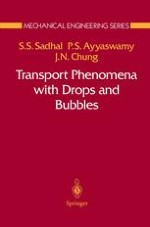1997 | OriginalPaper | Chapter
Compound Drops and Bubbles
Authors : S. S. Sadhal, P. S. Ayyaswamy, J. N. Chung
Published in: Transport Phenomena with Drops and Bubbles
Publisher: Springer New York
Included in: Professional Book Archive
Activate our intelligent search to find suitable subject content or patents.
Select sections of text to find matching patents with Artificial Intelligence. powered by
Select sections of text to find additional relevant content using AI-assisted search. powered by
The term compound drops generally refers to fluid particles which consist of at least two phases in yet another distinct continuous phase. Therefore, there are at least three well-defined phases is such a system. Compound drops and bubbles exist in three fundamental forms: a fluid particle entirely within another drop, a fluid particle attached to drop, or two separate fluid particles. The distinction whether a particle is a compound drop or a compound bubble may not be obvious in some cases, especially if the dispersed phase is partially liquid and partially gas. This situation occurs when there is direct-contact heat exchange between two immiscible liquids and the resulting dispersed phase consists of the liquid and the vapor together in the form of compound drops. The fluid dynamics and the heat transfer processes associated with a compound fluid-particle systems are, in general, very complicated and most of the analytical developments are relatively recent. Although the pioneering experimental studies of Sideman & Taitel [90] go back some 30 years, much of the subsequent experimental work has been carried during in the past 15 years.
